The UK’s housing landscape is evolving, with more homes, smarter energy use, and changing living patterns. Choose the region below to explore the latest insights:
England ScotlandLock, stock and new solar panels: the changing face of housing stock
England
- Dwelling stock in England has increased by 9% over the past decade to 25.4 million
- Over half of properties in the owner occupier sector are classified as 'under-occupied'
- Energy efficiency of England's housing stock has continued to improve
Over the past decade, the total housing stock in England has increased by 2.1 million dwellings (9%) to 25.4 million (in 2023). Interestingly, this was slightly above the rate of population growth in England over the same period (7%).
Of the total, 16.3 million dwellings (64% of the total) are owner occupied, while 4.9 million (19%) are privately rented, with the remaining 4.2 million (16%) in the social rented sector (local authority or housing association).
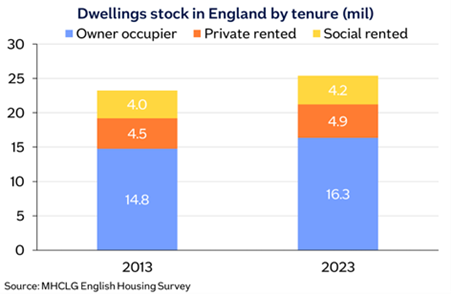
Property type - broadly stable
There has been relatively little change in the overall composition of the stock by property type over this period. However, there have been some shifts across tenure. In particular, flats now account for a higher proportion of privately rented dwellings - 42% of the stock - up from 38% in 2013. Flats are also the predominant property type in the social rented sector, accounting for 45% of dwellings. The picture is very different in the owner occupier sector, where flats represent just 10% of properties, with semi-detached most prevalent at 29%.
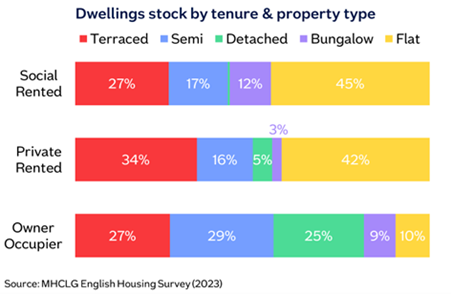
Floor area - a mixed picture
Typical property sizes have increased slightly over the last decade. Since 2013, the average floor area has increased from 95.3m2 to 96.2m2. The table below shows the increases across different property types. The largest increase has been in terraced houses, where the average floor area is 3.6% bigger than in 2013. But the average size of flat, the smallest property type, is now 1.7% smaller than 10 years ago at 60.3m2.
| Average floor area (m2) | 2013 | 2023 | % change |
|---|---|---|---|
| Flats | 61.4 | 60.3 | -1.7% |
| Bungalow | 77.0 | 77.5 | 0.6% |
| Terraced | 88.7 | 91.9 | 3.6% |
| Semi-Detached | 96.9 | 99.1 | 2.2% |
| Detached | 152.9 | 151.9 | -0.6% |
Reflecting the composition of the stock, the owner occupier sector has the highest average floor area at 112m2. The average floor area in the private and social rented sectors is smaller at 76m2 and 65m2 respectively, due to greater concentration of flats.
Dwellings in England tend to be a little smaller on average compared with some of our European neighbours. The average dwelling size in the EU is 103m2, although there is considerable variation amongst nations. The Netherlands, Norway and Belgium stand out as having the most spacious properties (on average), while typical properties tend to be much smaller in eastern European nations.

Bedrooms
87% of owner-occupied properties in England have at least one spare bedroom. Remarkably, 53% are classified as being 'under-occupied', that is to say they have two or more spare bedrooms. The proportion of under-occupied properties has been trending up over time.
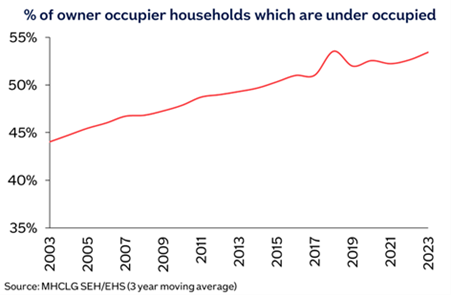
By contrast, in the private rented sector, only 16% of properties are 'under-occupied'. While in the social rented sector, overcrowding is more of a concern, with 8% of properties classified as overcrowded (households are said to be overcrowded if they have fewer bedrooms available that the notional number needed according to bedroom standard definition).
Energy efficiency and green measures
Decarbonising and adapting the housing stock is critical if the UK is to meet its 2050 emissions targets especially given that emissions from residential buildings account for 15% of the country's greenhouse gas emissions.
There is significant variation in the energy efficiency of the housing stock across different tenure types. Energy efficiency is typically much better in the social rented sector, due in part to tighter regulation. For example, 72% of properties in the social rented sector are rated A to C, compared with 48% in the private rented sector. The owner occupier sector is broadly similar to private rented, with 49% rated A to C.
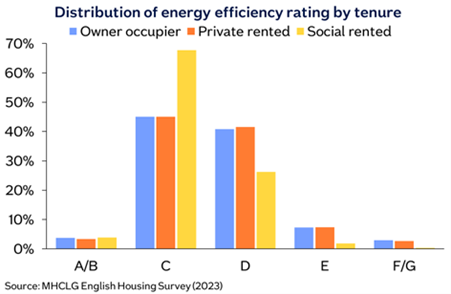
Over the past 10 years, energy efficiency has improved across the stock thanks to the higher efficiency ratings of newly built properties and the improvements carried out on many existing homes, such as loft and cavity wall insulation.
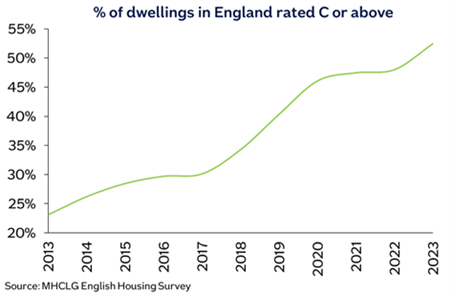
Low carbon technologies such as air source heat pumps are expected to play a greater role in future in terms of decarbonising and improving the efficiency of the housing stock. However, these are currently quite a rare feature, with only 276,000 dwellings in England using a heat pump as the primary heating system (1.1% of total stock). A higher proportion of rural dwellings have a heat pump (7.6%) compared to urban (0.5% of dwellings), which probably reflects more limited access to mains gas networks.
There is a much wider uptake of solar panels, with 1.5 million dwellings in England having photovoltaic (PV) panels - nearly 6% of dwellings. Over 15% of properties built in the last 10 years have PV. Another feature that is likely to become more widespread over time is access to electric vehicle (EV) charging. Currently, 1.8 million dwellings have access to an EV charge point - around 7% of the total stock. Again, this tends to be a feature of more recently built properties, with around 20% of dwellings built post-2012 having access to an EV charge point.
Scotland
- Dwelling stock in Scotland has increased by 8% over the past decade to 2.7 million
- Half of properties in the owner occupier sector are classified as 'under-occupied'
- Energy efficiency of Scotland's housing stock has continued to improve
Over the past decade, the total housing stock in Scotland has increased by c. 189,000 dwellings (8%) to 2.7 million (in 2023). Interestingly, this was above the rate of population growth in Scotland over the same period (4%).
Of the total, 1.6 million dwellings (60% of the total) are owner occupied, while 0.4 million (13%) are privately rented or with a job/business. 0.6 million dwellings (23%) are social rented from housing associations and local authorities. The remaining 0.1 million are either vacant private dwellings or second homes. Most of the growth in the Scottish housing stock over the last 10 years has been in the owner occupier sector.

Property type - broadly stable
There has been relatively little change in the overall composition of the stock by property type over this period. Tenements account for 24% of the Scottish housing stock, with a further 12% in other flats. Collectively, flats account for a much higher share of the housing stock in Scotland (36%) compared to England (21%).
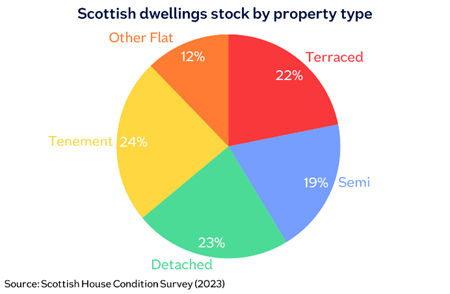
Tenements and other flats tend to be concentrated in urban areas within Scotland, where they account for over 40% of dwellings. Whilst in rural areas, detached homes are much more prevalent, accounting for nearly half dwellings.
Floor area - a mixed picture
Typical property sizes have increased slightly over the last decade. Since 2013, the average floor area has increased from 93.7m2 to 97.0m2. The table below shows the increases across different property types. The largest increases have been amongst tenements and other flats, although these remain the smallest property types.
| Average floor area (m2) | 2013 | 2023 | % change |
|---|---|---|---|
| Tenement | 66.1 | 69.0 | 4.4% |
| Other flat | 71.7 | 75.0 | 4.7% |
| Terraced | 90.1 | 88.0 | -2.3% |
| Semi-Detached | 93.9 | 97.0 | 3.3% |
| Detached | 142.2 | 146.0 | 2.7% |
Average flat sizes in Scotland tend to be a little larger on average compared with those in England, meaning that the overall average property size is broadly similar. But properties tend to be a little smaller on average compared with most European countries. The average dwelling size in the EU is 103m2, although there is considerable variation amongst nations. The Netherlands, Norway and Belgium stand out as having the most spacious properties (on average), while typical properties tend to be much smaller in eastern European nations.
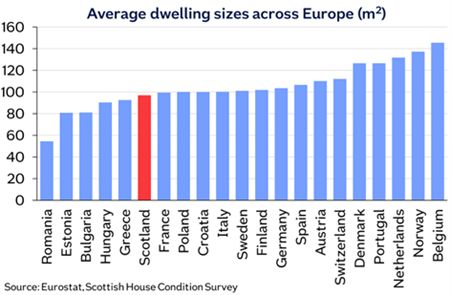
Bedrooms
70% of households in Scotland have at least one spare bedroom. 35% of households are classified as being 'under-occupied', that is to say they have two or more spare bedrooms, an increase of five percentage points compared with 10 years ago. 50% of owner occupier properties are classified as 'under-occupied'; compared with just 12% of those privately rented.
While in the social rented sector, overcrowding is more of a concern, with 4% of properties classified as overcrowded (households are said to be overcrowded if they have fewer bedrooms available that the notional number needed according to bedroom standard definition).
Energy efficiency and green measures
Decarbonising and adapting the housing stock is critical if the UK is to meet its 2050 emissions targets especially given that emissions from residential buildings account for 15% of the country's greenhouse gas emissions.
There is significant variation in the energy efficiency of the housing stock across different tenure types. Energy efficiency is typically much better in the social rented sector, due in part to tighter regulation. For example, 69% of properties in the social rented sector in Scotland are rated A to C, compared with 52% in the private rented sector. The owner occupier sector is broadly similar to private rented, with 51% rated A to C.
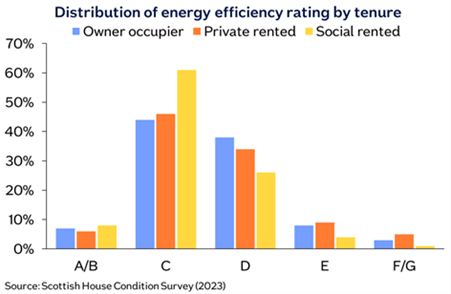
Over the past 10 years, energy efficiency has improved across the stock thanks to the higher efficiency ratings of newly built properties and the improvements carried out on many existing homes, such as loft and cavity wall insulation.

Low carbon technologies such as air source heat pumps are expected to play a greater role in future in terms of decarbonising and improving the efficiency of the housing stock. However, these are currently quite a rare feature, with only 45,000 in Scotland using a heat pump as the primary heating system (2.0% of total stock). There is a much wider uptake of solar panels however, with 167,000 dwellings in Scotland having photovoltaic (PV) panels - 7% of dwellings.
Explore our news and insights
For more like this, check our news and insights page regularly to discover our latest reports, expert analysis, and updates.
